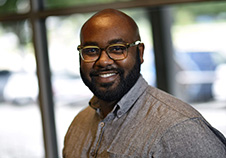Office of Research & Development |
 |


While wearing a wrist sensor, the patient flexes the elbow repeatedly for 20 seconds. Photo courtesy of Dr. Bijan Najafi.
April 28, 2021
By Tristan Horrom
VA Research Communications

VA ear surgeon studies management of severe hearing loss in Veterans

Veteran disability payments led to fewer hospitalizations

VA grants first diversity, equity, and inclusion research awards
A simple test with a wrist-worn sensor can easily assess frailty and mobility in surgery patients, found a study that included researchers at the Michael E. DeBakey VA Medical Center and Baylor College of Medicine. The test could help predict the risk of surgery in patients with mobility limitations.
The results appeared April 1, 2021, in the journal Gerontology.
Frailty is defined as “decreased physiological reserve in older adults when exposed to a stressful event.” It is a risk factor for complications after all types of surgery. Older, frail patients may be weaker and less able to recover from surgery, increasing the danger. More than half of surgeries performed in the United States are on patients 65 years or older.
Despite the danger, no consensus exists on how best to measure frailty. Functional mobility tests such as walking speed are often used for this purpose before surgery. However, these tests cannot be used in patients with limited mobility, such as a patient in a wheelchair or with balance problems.
To address this problem, researchers developed a frailty test that uses only the patient’s arm. The patient wears an inertia sensor, such as a smart watch, on the wrist. While seated, the patient flexes and extends the elbow as quickly as possible in 20 seconds. The test can be used to assess weakness, slowness, range of motion, and exhaustion.
The researchers measured how 100 patients age 65 or older performed on the elbow test, and compared the results to their scores on three common measures of functional mobility and frailty: gait speed, the timed up-and-go test, and the five times sit-to-stand test.
The elbow test accurately predicted how well participants did on all three mobility tests. Patients with poorer performance on the upper-limb test also had poorer performance in the tests involving the lower limbs.
The results show that the upper-extremity frailty index can assess frailty in much the same way as the mobility tests. The elbow test will make it easier to predict frailty in a wide variety of patients, according to the researchers. It can be used in patients with pre-existing mobility impairments, unlike tests such as the timed up-and-go, which measures how long it takes a patient to stand from a chair, walk three meters and back, and sit down again. The new test also takes less time to perform and does not need as much space as the mobility tests. This means that the elbow test can be used in outpatient settings where space may be limited.
In addition to showing that the new test is accurate at predicting frailty, the results also suggest an association between upper and lower limb functioning, say the researchers. Weakness in the upper limbs could help predict weakness in the lower limbs, and vice versa.
“The development and increasing use of technology in key aspects of our lives represents a creative opportunity to address unmet clinical needs,” said study corresponding author Dr Bijan Najafi, a professor in the Department of Surgery and the Huffington Center on Aging at Baylor College of Medicine. “This study is the fruit of an interdisciplinary collaboration between engineers and clinicians focused on simplifying physical frailty diagnosis. This quick and low-risk test based on a smartwatch-like wrist sensor could facilitate the diagnosis of frailty during routine medical visits, empowering clinicians to provide personalized care.”
The study was supported by the National Heart, Lung, and Blood Institute; the National Institute of Aging; and the Houston VA Health Services Research and Development Center for Innovations in Quality, Effectiveness and Safety.
VA Research Currents archives || Sign up for VA Research updates